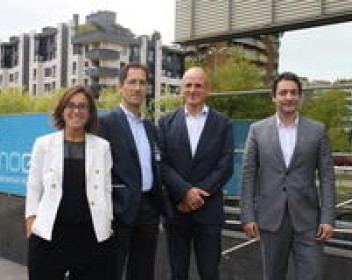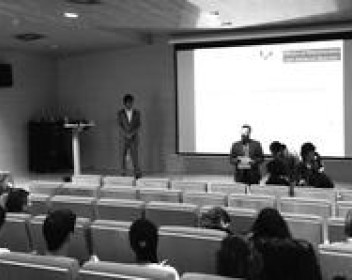Newsroom
News
ACSnano: "Probing the Effect of Force on HIV-1 Receptor CD4"
NanoGUNE’s Nanobiomechanics Group, led by Ikerbasque Professor Raul Perez-Jimenez, in collaboration with the Department of Biological Sciences of the Columbia University (US) and the Aaron Diamond AIDS Research Center (US), has tested that mechanical force may help HIV to invade cells. The research has been recently published in ACS Nano (DOI: 10.1021/nn503557w)
ETP Nanomedicine Annual Event 2014
NanoGUNE hosts more than 120 experts in nanotechnology and medicine at the 2014 Annual Event & General Assembly of the European Technology Platform on Nanomedicine (ETPN). The ETPN event has taken place on 15 and 16 October 2014, co-organized by the nanoBasque Agency (SPRI) and nanoGUNE, the Basque Nanoscience Cooperative Research Center.
Fundación Repsol Entrepreneurs Fund supports EVOLGENE project
The EVOLGENE project, directed by nanoGUNE’s researcher Raul Perez-Jimenez, has been selected as one of the four “Ideas” that will be supported by the Entrepreneurs Fund of Fundación Repsol. The paleoenzymology project aims at reconstructing ultra-efficient ancestral enzymes for use in industry.
The Ludwig-Genzel-Prize 2014 is awarded to Rainer Hillenbrand
The Ludwig-Genzel-Prize 2014 has been awarded to the Ikerbasque Research Professor at nanoGUNE and the UPV/EHU Rainer Hillenbrand for “the design and development of infrared near-field spectroscopy and the application of this novel spectroscopic method in different areas of natural sciences”.
Sir John Pendry awarded the Kavli Prize 2014 in nanoscience
Sir John Pendry, member of the scientific committee of the Donostia International Physics Center (DIPC) and chairman of the international advisory committee of nanoGUNE, has been awarded the prestigious Kavli Prize, considered as the Nobel Prize for Technology.
"Polythiophene-based nanoscale lateral devices", PhD thesis by Thales V. A. G. de Oliveira
Thales de Oliveira, Pre-doctoral Researcher at the Self-Assembly Group at nanoGUNE, received his PhD at the University of the Basque Country (UPV/EHU) after the defense of his thesis project on Friday 23 May 2014. His research work, entitled “Polythiophene-based nanoscale lateral devices”, has been developed under the supervision of Dr. Alexander Bittner and Dr. Luis E. Hueso, Ikerbasque Research Professors and Leaders of the Self-Assembly and Nanodevices Groups, respectively.
Science: Flatland optics with graphene
Researchers from nanoGUNE, in collaboration with ICFO and Graphenea, introduce a platform technology based on optical antennas for trapping and controlling light with the one-atom-thick material graphene. The experiments show that the dramatically squeezed graphene-guided light can be focused and bent, following the fundamental principles of conventional optics. The work, published yesterday in Science, opens new opportunities for smaller and faster photonic devices and circuits.
"Resistive switching in Hafnium oxide", PhD thesis by Raul Zazpe
Raul Zazpe, Pre-doctoral Researcher at the Nanodevices Group at nanoGUNE, received his PhD at the University of the Basque Country (UPV/EHU) after the defense of his thesis project on Wednesday 30 April 2014. His research work, entitled “Resistive switching in Hafnium oxide”, has been developed under the supervision of the Nanodevices Group Leader and Ikerbasque Research Professor Dr. Luis Hueso.
State-of-the-art technology at the service of academia and companies
NanoGUNE has set up its External-Services department, a comprehensive proposal combining cutting-edge equipment and qualified personnel to serve academia and companies.
Two-Dimensional Programmable Manipulation of Magnetic Nanoparticles on-Chip
Researchers from the Nanomagnetism Group at nanoGUNE have developed a novel device for on-chip selective trap and two-dimensional remote manipulation of single and multiple fluid-borne magnetic particles using field controlled magnetic domain walls in circular nanostructures. The combination of differently shaped nanorings and field sequences allows for the remote manipulation of magnetic particles with high precision along any arbitrary pathway on a chip surface.
Agenda
| Mon | Tue | Wed | Thu | Fri | Sat | Sun |
|---|---|---|---|---|---|---|
|
29
|
30
|
31
|
1
|
2
|
3
|
4
|
|
|
|
|
|
|
|
|
|
5
|
6
|
7
|
10
|
11
|
||
|
|
|
|
|
|
||
|
12
|
13
|
14
|
15
|
16
|
17
|
18
|
|
|
|
|
|
|
|
|
|
19
|
20
|
21
|
23
|
24
|
25
|
|
|
|
|
|
|
|
|
|
|
26
|
27
|
28
|
29
|
30
|
31
|
1
|
|
|
|
|
|
|
|
|
Events
- 04/02/2026 to 06/02/2026
nanoGUNE Winter School 2026
nanoVISUALS
Find events' photos, experimental images, videos, audios, and nanoGUNE's corporate images.



